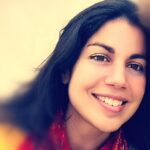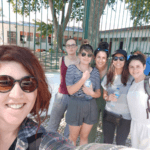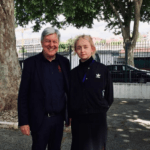This training course was organized mainly into two parts: the seminars held by Bernd Ruf and the workshops. Bernd Ruf’s work was admirable as he transferred years of experience and knowledge about the field of children’s psychology to us and taught us the foundations of Emergency and Trauma Pedagogy. From the two workshops, we learned the importance of promoting rhythmic movement and artistic expression that helped the children stay focused on the moment and activate their body movements. Through my experience from working with clay and drawing, I recognised many times that unconsciously the body “remembers” without even the necessity of words.
Teaching children and youngsters who have been through traumatic experiences can be an enormous challenge. In partnership with the Portuguese Spin Association and the German Friends of Waldorf Education, youth workers from eight countries learned how to apply emergency pedagogy concepts and improve the psychosocial well-being of young people all over Europe.
For me participation is a willingness to both learn and share competences, tools and knowledge with others for community development.
Project Coordinator Sara Segurado has told us about this engaging training programme:
How would you define emergency pedagogy?
It is an approach that is mainly applied by Waldorf teachers and people who are part of emergency pedagogy missions. Its concept is based on the methods of Waldorf education and related therapies. As emergency pedagogy is used to provide relief and stabilization after shock, it offers new possibilities for educators, trainers and youth workers, especially for those who deal with youngsters at risk of developing post-traumatic stress disorder (PTSD).
How did you come to connect this method to Erasmus+?
During a terrible wildfire in Portugal, our organisation was contacted by teachers asking for help with traumatised students. Many people had lost their homes and died; it was a catastrophe. Back then we had no emergency pedagogy team in the country, so I contacted the German Friends of Waldorf Education. We couldn’t involve them immediately, but our local network wanted to develop the tools needed if a similar situation arose in the future. So we agreed to plan a project that included a 6-day training course.
Who was this training course for?
Youth workers. Involving young people in learning activities is often challenging, so getting to know the blocks behind certain behaviours can be extremely helpful! We addressed youth workers working with refugees, earthquake victims, street projects and so on. We also wanted to target youth workers who had personal experience of trauma. For example, one of our participants was a Syrian refugee who worked as a cultural mediator at an NGO in Lisbon.
How did you design the project plan?
Our NGO, Spin, wrote a draft and a call for partners, describing our objectives. We then prepared a “memorandum of understanding” addressing the various aspects of project communication, visibility and dissemination, and a 14-month timeline. Our partners shared their feedback and collaborated on the application. As for the workshops, we were fortunate to enlist the help of the founder of emergency pedagogy concept, Bernd Ruf, who along with two of his colleagues from the Friends of Waldorf Education offered to provide training.
How did you find the organisations to collaborate with?
We are well established and have developed a long list of partners over the years. Often we also use tools like Otlas to find new organisations, but this project was an exception. Since we were introducing a new concept, we chose to work with partners we already knew and trusted. Of course, we wanted to include NGOs that worked with youngsters at risk, and concentrated on countries without any experience of emergency pedagogy.
How did you select the course participants?
After the project application was approved at the end of 2018, we started proper preparation. Together with our partners we agreed on an application form for participants. The selection was made by the partner organisations, with the final approval of Spin. To be considered, each candidate would agree to write at least one article about the project and organize at least one multiplier event. We also committed to running open sharing sessions, where participants could lead workshops and share their expertise.
How did you engage participants in the activities?
We didn’t have to make serious efforts as participants were very motivated. We shared as much information as possible with them about the course in advance, and our partner organisations ran an introduction session to prepare them. We also created a closed Facebook group, asking participants to contribute with their experiences. This method of sharing inspired even the less confident members to apply their new knowledge in their countries after the course.
How was the programme structured?
Every morning began with an energiser with songs. Sessions on theoretical concepts were followed by practical sessions, with coffee breaks, meals and informal moments throughout the day. We ended with feedback sessions, which included drawing, gestures and performance, as a means of reflecting on what they had learned. We encouraged participants to keep a diary that would be useful for preparing the Youthpass certificate, as well as their article and multiplier events. At the end they also received an extra certificate that corresponds to the first module of the German association’s official course.
Can you give some examples of the activities you did?
We started the week with a storytelling night open to the public, where participants shared a legend in a creative way. Then we had an “NGO fair” where participants presented their work to each other and local associations. A cine forum was hosted by the European University of Lisbon where Bernd Ruf presented short videos about his international interventions. People could also get copies of Ruf’s book on emergency pedagogy and sign up for our newsletters.
Where else did you share your results with the public?
The project took place in a socially marginalised neighbourhood of Lisbon. Spin works to change the negative image of this district, and the municipality allowed us to turn a local abandoned school into a community space where Spin Hostel was built. After each social, recreational and educational project we host there, we ask the groups using this space to give something back to the community. One group offered free hugs, while the emergency pedagogy group organised an exhibition of their works from the music, rhythmic movements and art therapy workshops.
What kinds of challenges arose?
Cyclone Idai hit Mozambique just before the course began, and two of our trainers were part of the emergency pedagogy team sent there. They were immediately replaced, but we needed to bring the new trainers up to speed very quickly. Fortunately, with the help of three people from Spin and Bernd Ruf we were able to support them.
How did the participants of the course deal with the recent pandemic?
As most youth workers had to rely on online contact during the lockdown, they needed to find new ways to teach their clients how to maintain a state of inner calm. We encouraged them to use more art, music and all sorts of stress relief methods.
Do you have some advice for other organisations eager to organize a successful course?
Having the opportunity to discuss methods and share experiences of cases is essential, so ensure that your project encourages these kinds of exchanges. It is also a good idea to think about making your project visible. Although there are great channels out there such as SALTO, some youth workers simply don’t know about the tools and training opportunities available.
What suggestions would you offer to other youth workers?
Before helping others, it is important to be centred and be aware of our own psychological-social hygiene. Trauma can be contagious and dealing with it every day can affect us too, so we need to take care of ourselves. Also, learning about emergency pedagogy and understanding how trauma is created helps us prevent its development.
How did you follow up on the project?
The emergency pedagogy group in Portugal (now with more than 100 members!) created the first module of a course in Portuguese, which is already available online. It also organised an offline workshop in February that many educators attended. We have planned to extend the training course to be taught in other countries.
Project outcomes
Take a look at the main activities and workshops of the training course!
Video-story
Creating this short film was a great way to show to the world and remind participants themselves of what they have learned and shared together.
About the project
Supported by:
Erasmus+ / Mobility of Youth Workers
EU Youth Programme Priority:
Inclusion and Diversity
Topic:
Youth Participation / Skills Development and Volunteering
Youth Goals:
Visibility:
The project was promoted during the training course by events such as the Cine Forum and an NGO fair. Plus, each participant produced an article and a follow-up event after the course! Videos and an e-brochure created by participants enhanced the visibility of the project.
Organisations involved:
Associação Spin para o Intercâmbio, Formação e Cooperação entre os Povos (PT); YOU IN EUROPE (EL); CRESCER NA MAIOR – ASSOCIACAO DE INTERVENCAO COMUNITARIA (PT); TRONDELAG FYLKESKOMMUNE (NO); VICOLOCORTO ASSOCIAZIONE (IT); SOCIALNA AKADEMIJA – ZAVOD ZA IZOBRAZEVANJE, RAZISKOVANJE IN KULTURO (SI); Freunde der Erziehungskunst Rudolf Steiners e.V. (DE); ASOCIACION MUNDUS – UN MUNDO A TUS PIES (ES); INSTITUTUL ROMAN PENTRU ACTIUNE, INSTRUIRE SI CERCETARE IN DOMENIUL PACII – PEACE ACTION, TRAINING & RESEARCH INST OF ROMANIA (RO)

















